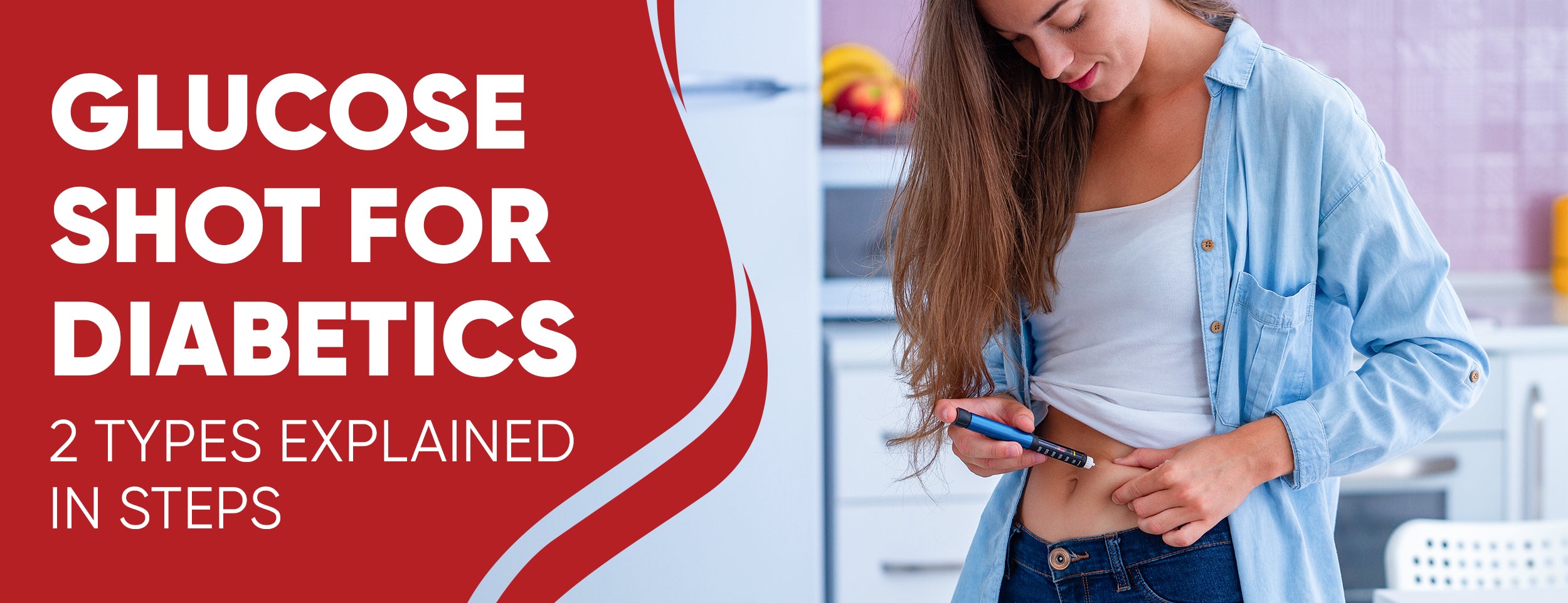Insulin shots are vital for managing diabetes. They regulate blood sugar by aiding glucose absorption into cells, maintaining optimal levels. Without insulin, glucose accumulates, posing health risks. Shots supplement insufficient insulin production or utilization.
For a patient with type 1 diabetes, the insulin regimen typically begins with two daily injections of different types. Daily injections may increase to three or four, depending on blood glucose levels.
This blog post explores diabetes insulin shots, covering topics from types of diabetes and administering injections to blood sugar monitoring and lifestyle management.
Diabetes Insulin Shots: An Overview

In diabetes, insufficient insulin production or poor cell response leads to high blood sugar levels and potential complications, including heart disease, kidney failure, nerve damage, and vision loss.
Insulin shots are common and effective for treating diabetes. They mimic the action of natural insulin, lowering blood sugar levels and preventing complications. People with type 1 diabetes, who can't produce insulin, and some diabetics with type 2 diabetes may require insulin shots to control their blood sugar.
Diabetes Insulin Shots: Types
Different types of insulin shots are available for diabetes treatment. They vary in how quickly they start working, how long they last, and when they have the most effect. The main types of insulin shots are:
- Rapid-acting insulin: Works in 15 minutes, peaks in about an hour, and lasts 2 to 4 hours. It is usually taken before meals to cover the rise in blood sugar from food.
- Short-acting insulin: Works within 30 minutes, peaks in 2 to 3 hours, and lasts 3 to 6 hours. It is also taken before meals but may be more suitable for people who eat at different times or have unpredictable blood sugar levels.
- Intermediate-acting insulin: Acts in 2 to 4 hours, peaks in 4 to 12 hours, and lasts for 12 to 18 hours. It is usually taken once or twice daily to provide insulin throughout the day and night.
- Long-acting insulin: Starts working in a few hours, does not have a noticeable peak, and lasts up to 24 hours. It is usually taken once a day to provide a steady insulin level.
- Premixed insulin: A combination of two different types designed to provide both mealtime and background insulin in one injection.
The type and amount of insulin shots a person with diabetes needs depend on factors like blood sugar levels, eating habits, physical activity, weight, age, and overall health. A person may need to adjust their insulin regimen as their situation changes. A doctor or diabetes educator can help choose the best type and dose for individual needs.

Administering Insulin Shots
Insulin shots are typically administered using an insulin pen or an insulin syringe. The insulin pen consists of a cartridge of insulin and a disposable needle, while the insulin syringe consists of a barrel for measuring doses and an attached needle. The process for using each device is as follows:
For the insulin pen:
- Begin by washing your hands with soap and water or using an alcohol-based sanitizer.
- Check your insulin's expiration date and appearance; avoid using it if it is cloudy.
- Prime the insulin pen by dialing 2 units and pressing the button until a drop of insulin appears at the needle tip, eliminating air bubbles.
- Choose an injection site on your abdomen, thighs, upper arms, or buttocks, avoiding areas like scars, moles, bruises, or regions with lipodystrophy.
- Clean the injection site with an alcohol swab and allow it to dry.
- Pinch up a skin fold and insert the needle at a 90-degree angle. If using a short needle (4 to 6 mm), there's no need to pinch the skin, while very thin individuals may require a 45-degree angle.
- Inject the insulin by pressing the button on the pen and counting to 10 before removing the needle to ensure complete delivery.
- Dispose of the used needle in a sharps container, ensuring no needle reuse or sharing.
For the insulin syringe:
- Again, wash your hands thoroughly.
- Roll the insulin vial between your palms to mix the contents if cloudy or exhibiting particles. Avoid shaking vigorously to prevent air bubble formation.
- Follow the steps from the insulin pen instructions above.
When administering insulin shots, it's vital to employ proper injection techniques and sites to minimize discomfort, bruising, bleeding, infection, and lipodystrophy while enhancing insulin absorption and effectiveness. Here are some tips:
- Rotate injection sites within each area to prevent lipodystrophy and optimize absorption.
- Allow insulin to reach room temperature before injecting to reduce pain and irritation.
- Avoid injecting into muscles or veins, leading to low or erratic blood sugar levels.
- Refrain from massaging or rubbing the injection site, as it can accelerate insulin absorption and cause low blood sugar.
- Do not inject insulin into an area that will be exercised soon, such as the thigh, before running or cycling to prevent fast absorption and subsequent low blood sugar.
Frequency and Dosage of Insulin Shots

The insulin dosage and frequency for individuals with diabetes vary based on their specific diabetes type, eating habits, exercise habits, weight, age, and general health condition.
As circumstances change, a person with diabetes must adjust their insulin dose with time. Consulting with a doctor or a diabetes educator can provide valuable guidance in determining the optimal dosage and frequency tailored to their preferences and needs.
Insulin Shots For Type 1 Diabetes
If you have type 1 diabetes, you must take insulin shots several times daily to replace the insulin your body doesn't produce. Typically, you'll need two insulin shots: one that lasts long and another that works quickly or shortly.
- A long-acting insulin provides constant glucose throughout the day and at night. It helps maintain stable blood sugar levels between meals and during sleep. You usually need to take it once or twice a day, depending on the type and dose of insulin you use.
- A rapid-acting or short-acting insulin handles the increase in blood sugar from eating. It helps lower blood sugar levels after meals and snacks. You must take it before each meal or snack, about 15 to 30 minutes before eating.
- Sometimes, you may need extra doses of short-acting or rapid-acting insulin to correct high blood sugar levels. This is known as a correction dose or a bolus dose. You can use a formula or a sliding scale to calculate the correct dose based on your blood sugar level and insulin sensitivity.

Insulin Shots For Type 2 Diabetes
People with type 2 diabetes may or may not require insulin shots, depending on how well other diabetes treatments control their blood sugar levels. These treatments include oral medications, diet, and exercise. Some individuals with type 2 diabetes may only need one or two shots of long-acting or intermediate-acting insulin daily.
This provides a steady amount of insulin all day and all night long. Others may need to add insulin that acts quickly or quickly before meals or snacks to manage the increased blood sugar caused by eating. Insulin with a short or rapid action may sometimes be necessary for high blood sugar control.
- The dose of insulin shots for someone with type 2 diabetes depends on several factors.
- The type and amount of carbs they eat.
- When and how often they have meals and snacks.
- How much and how intense their physical activity is.
- Other medical conditions or medications that affect blood sugar levels.
- The results of their blood sugar testing.
- Blood sugar control goals.
A person with type 2 diabetes might need to adjust their insulin dose based on these factors. For example, they might increase the dose if they eat more carbs, skip meals, reduce physical activity, get sick, or experience stress.
They might decrease the dose if they eat fewer carbs, have an extra meal or snack, increase physical activity, start a medication that lowers blood sugar, or have low blood sugar (hypoglycemia).
Advances in Insulin Delivery Methods

Insulin shots aren't the sole method for delivering insulin. Alternative approaches are being developed that may provide greater convenience, comfort, accuracy, or flexibility for individuals with diabetes requiring insulin therapy. Some of these methods include:
Insulin Pumps
A small device delivers continuous insulin doses through a thin tube inserted under the skin. The pump can be programmed to deliver different amounts of insulin according to blood sugar levels, dietary habits, and physical activity. It can also deliver a larger dose before meals or when blood sugar levels are high. Insulin pumps offer flexibility and accuracy in insulin delivery but require careful monitoring and maintenance.
Insulin Pens With Smart Features
Some pens can record insulin doses and transmit data to a smartphone app or cloud platform. This helps people with diabetes track usage and avoid missed or double doses. Some pens also provide reminders, alerts, or feedback to optimize dosing and timing.

Inhalable Insulin
Insulin can be breathed in through an inhaler. It works rapidly, starting within 10 minutes and lasting 2 to 3 hours. Inhalable insulin covers blood sugar rise from food intake. It offers convenience but may not be suitable for people with lung problems.
Insulin Patches
A device that delivers continuous doses of insulin through microneedles. The patch can be worn for up to 24 hours and programmed for different doses. It can also deliver a bolus before meals or correct high blood sugar levels. Insulin patches offer convenience but are still in development.
Oral Insulin
Insulin can be swallowed as a pill or capsule. It survives the stomach and is absorbed in the small intestine. Oral insulin begins to work within 15 minutes, peaks within an hour and lasts two to four hours. It prevents blood sugar from rising as a result of eating. Oral insulin is still in development.
Cost and Accessibility of Insulin Shots

Insulin shots are important for people with diabetes who require insulin therapy to manage their blood sugar levels and prevent diabetes complications. The cost and availability of insulin shots can differ based on location, insurance, and the type of insulin needed.
The Cost of Insulin Shots
Insulin shots can be expensive and a financially burden for diabetics who need them. The cost of insulin shots may vary based on different factors, including:
- The kind, brand, maker, pharmacy, and place of the insulin shots.
- The number and how often you take insulin shots.
- The kind and amount of insurance coverage or financial support.
- Assistance programs or discounts may be available and accessible to those who meet the eligibility criteria.
According to a report by the American Diabetes Association (ADA), the price of insulin in the US increased by 262% from 2007 to 2019. This means that people with diabetes who need insulin shots might have to pay hundreds or thousands of dollars each month for their insulin, depending on their insurance and plan.
In the UK, diabetics who require insulin therapy get their diabetes medicines and supplies, including insulin shots, for free through the National Health Service (NHS). The NHS covers all approved types of insulin shots in the UK.
But some people with diabetes may have to pay for other costs related to their insulin therapy, like glucose meters, test strips, lancets, needles, syringes, pens, pumps, or sensors.

The Accessibility of Insulin Shots
Getting insulin shots can be challenging for people with diabetes who need them. There are a few factors that affect the accessibility of insulin shots, like:
- How available and supplied the insulin shots are.
- The quality and safety of the insulin shots.
- How convenient and comfortable the insulin shots are.
- Any legal or regulatory issues related to insulin shots.
Diabetes patients may have trouble getting or using insulin shots because of shortages, delays, defects, counterfeits, or recalls. They may also need help finding or affording the devices or supplies needed to administer the shots, like needles, syringes, pens, or pumps.
Some people with diabetes may experience pain, discomfort, or side effects from insulin shots, such as injection site reactions or lipodystrophy. Legal or regulatory barriers may also arise when buying or traveling with insulin shots across different countries or regions.
Some programs and resources can assist diabetics who require insulin shots. These include:
- Patient assistance programs: Some insulin manufacturers offer assistance programs to provide free or discounted insulin shots for eligible individuals who have low income, no insurance, or inadequate insurance coverage.
- Copay cards and coupons: Insulin manufacturers offer copay cards and coupons to help reduce the cost of insulin shots for people with diabetes who have insurance coverage.
- Generic and biosimilar insulin: There are cheaper and more accessible versions of insulin shots known as generic and biosimilar. These versions are similar to the original brand-name insulins.
- Online pharmacies and mail-order services: Buy insulin shots from reputable online pharmacies or mail-order services for convenience and cost-effectiveness. Ensure quality and legality by choosing licensed providers that require a valid prescription.
- International sources: Some individuals with diabetes may buy cheaper and more accessible insulin shots from other countries. This comes with risks like legal issues, customs regulations, and quality control.
Managing Diabetes with Insulin Shots

Insulin shots are crucial for diabetes management in people who require insulin therapy to control blood sugar levels and prevent complications. Following five steps to care for physical and mental health alongside insulin shots is important.
Step 1: Monitor Your Blood Sugar Levels Regularly
Regularly monitoring blood sugar levels is essential for people with diabetes using insulin shots. It aids in adjusting insulin doses based on sugar levels, eating habits, exercise, and other factors. It helps detect and treat low or high blood sugar before they become serious or life-threatening.
You can monitor blood sugar levels using a glucose meter, continuous glucose monitor (CGM), or flash glucose monitor (FGM). A glucose meter measures blood sugar from a finger prick. A CGM continuously measures blood sugar from a sensor under the skin. An FGM monitors blood sugar with a sensor on the upper arm, scanned with a reader or smartphone.
Monitor blood sugar levels at least four times daily for people with type 1 diabetes, use an insulin pump, or experience frequent hypoglycemia or hyperglycemia. Record levels and factors impacting them (e.g., food, exercise, stress, illness, medication, etc.) to identify patterns and make necessary adjustments.
Step 2: Follow a Healthy Diet
Maintaining a healthy diet can control blood sugar, body weight, cholesterol, and blood pressure and prevent diabetes complications. For insulin users with diabetes, a healthy diet includes:
- Variety of foods from all food groups: fruits, veggies, whole grains, lean proteins, low-fat dairy, nuts, seeds, healthy fats.
- Consistent and balanced carbohydrate intake throughout the day.
- Limited added sugars, saturated fats, trans fats, salt, and alcohol.
Carbohydrates are the primary source of glucose, impacting blood sugar levels the most. Learn carbohydrate counting to match insulin doses. Use resources like books, apps, or websites for estimating carbohydrate content.
Follow regular meal and snack times to stabilize blood sugar. Administer insulin before or after meals, depending on insulin type. Utilize tools such as insulin calculators, apps, or websites for guidance on dosage and timing.
Step 3: Exercise Regularly
Regular exercise can help lower blood sugar levels, improve insulin sensitivity, reduce cardiovascular risk factors, strengthen muscles and bones, enhance mood, and prevent diabetes complications.
Aim for 150 minutes of moderate-intensity weekly activity, like brisk walking, cycling, swimming, or dancing. Incorporate strength training exercises at least twice weekly, such as weightlifting, push-ups, or resistance bands.
Be sure to check with your doctor before starting a new exercise program. Monitor blood sugar levels before, during, and after exercise, adjusting insulin doses and carbohydrate intake accordingly. Use exercise calculators, apps, or websites to estimate exercise effects on blood sugar levels and insulin requirements.

Step 4: Take Care of Your Mental Health
Taking care of your mental health is crucial for individuals with diabetes on insulin shots. Diabetes can be stressful and demanding, impacting mental well-being and quality of life. Anxiety, depression, anger, frustration, guilt, shame, fear, and isolation may be experienced. Coping with complications, managing costs, and balancing care with other aspects of life pose further challenges.
Seek professional help and support from loved ones, peers, or online communities who understand. Explore mental health tools like apps, websites, or podcasts to manage stress and boost self-esteem.
Step 5: Consult Your Doctor or Diabetes Educator Regularly
Regularly consulting your doctor or a diabetes educator is crucial for people with diabetes who take insulin shots. They can help you monitor your blood sugar levels, adjust your insulin regimen, prescribe other treatments if needed, screen for complications, and provide education on effective diabetes management.
See your doctor or diabetes educator every 3 to 6 months or more often if you have concerns. Have regular check-ups and the HbA1c test to measure long-term blood sugar control. This test shows your average blood sugar level over the past 2 to 3 months and helps evaluate treatment effectiveness.
Managing diabetes with insulin shots is challenging but rewarding. Follow these steps to care for your physical and mental health, achieve better blood sugar control, and prevent complications. Remember, you're not alone healthcare providers, family, friends, peers, and online communities offer support.
Conclusion:
Insulin shots are a common and effective way to treat diabetes. Using them requires commitment and responsibility. People with diabetes should know the pros and cons of this treatment, seek help and support when needed, and maintain a healthy lifestyle.
Regular monitoring of blood sugar levels and regular consultations with doctors or diabetes educators are also important. It's important to note that insulin shots are not the end-all-be-all for diabetes treatment. Ongoing research and development aim to improve the quality and availability of insulin therapy.
There are also advancements in insulin delivery methods that may provide more options and benefits for people with diabetes who rely on insulin shots. These advancements could potentially change how diabetes is managed in the future.














